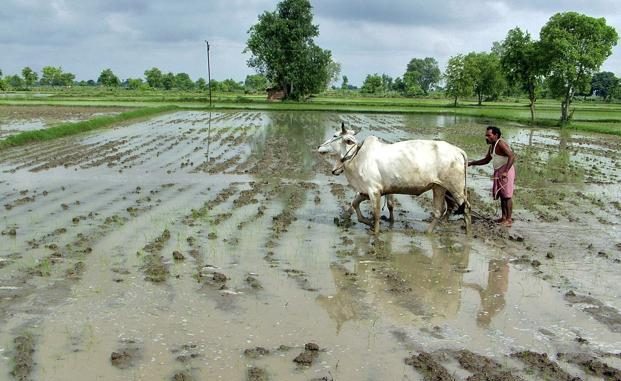
By Sanjay Kaul
China’s example shows the benefits of the rural workforce shifting from the farm to the non-farm sector
The government announced its ambitious dream of doubling farmers’ income by 2022-23 in 2015-16. Incomes would have to grow annually by 10.4% to double in seven years.
The data on growth rates of farm income given by NITI Aayog in its policy paper on doubling farmers’ income shows that the real income of farmers has grown at a rate of 3.4% between 1993 and 2016. Further, if we use the gross value added (GVA) by agriculture as a proxy for farm incomes, we see that the GVA of agriculture at constant prices has historically grown, on an average, at a rate of 3% per annum. Following this trend, the real GVA took as many as 25 years (in the period 1990-2016) to double!
Recent efforts to improve farmers’ income have been focused on raising minimum support prices (MSPs). Historical evidence shows that MSP does not directly translate into higher incomes for farmers due to a deficient ground-implementation framework. Additionally, high MSPs result in market distortions and render Indian exports uncompetitive in world markets.
Thus, it does not appear realistic to double the real income of a rural household from agriculture alone. Incomes of rural households need to be augmented from non-farm income sources.
Notwithstanding challenges, the industry and service sectors have shown more consistent real growth in the last five years and a shift of workforce is required from the farm to the non-farm sector. Open unemployment is already high. The problem of disguised unemployment and under-employment, fuelled by fragmentation of landholdings, has long plagued the Indian agricultural sector. More than 45% of the workforce is engaged in a sector which contributes less than 17% to the country’s gross domestic product. This share is poised to further decline; agriculture cannot sustain households dependent on it for long. The sooner we recognize this, the faster we will be able to evaluate policy alternatives.
For instance, China, whose farm sector was similar to that of India in the 1960s, now employs only 27.7% of its workforce in agriculture. It has left India far behind in value of agriculture production and rural household incomes. This is because first, it produces much more from each hectare than India does, and second, it rigorously developed non-farm income sources.
Through major reforms in the 1970s, China boosted its agricultural productivity and at the same time, established urban labour markets by developing non-state enterprises, making it possible for rural migrants to seek jobs in towns and cities. Additionally, non-farm activities were rapidly developed in rural China, which absorbed a large quantity of surplus agricultural labour. This form of labour mobility was christened “leave the land, but not the village”.
Labour-intensive “township and village enterprises” (TVEs) were established in rural areas and saw keen participation from the private sector due to low-wage labour. TVEs became engines of growth for Chinese rural non-farm sector.
As a result, China’s rural non-farm sector has emerged as a major source of the high rates of economic growth in the recent past. Rural poverty levels are as low as 2.5% now in China while in India, they remain as high as 40% in some states.
Taking a cue from its neighbour, India needs to undertake a drive to intensify non-farm employment in its rural areas. Rural households need to be encouraged and enabled to engage household members in non-farm livelihood and contribute to the household income through remittance earning or direct earning.
Non-farm activities already generate close to two-thirds of the income in Indian rural areas but this hasn’t translated into a significant rise in employment opportunities in these areas or bridged disparities in worker productivity.
The thrust on the manufacturing sector in rural areas has been woefully inadequate. Manufacturing activity, especially employing modern technology, in rural areas has been neglected. Lack of required skills and technical knowledge are the major barriers, apart from good quality infrastructure and power. This has led to minimal private sector investment. Growth of rural manufacturing requires massive investment in skill formation and entrepreneurship development as well as in infrastructure.
While direct employment generation programmes continue to be of importance, greater incentives need to be put in place for attracting non-farm activities, including household and non-household manufacturing, processing, mining and quarrying, repair, construction, trade and commerce, transport, communication and tourism, among others.
Marketing links between the village entrepreneurs and the larger business firms located in towns/cities need to be improved besides upgrading financial/credit facilities, research and development, improving education and awareness, and women’s participation.
Overreliance on using pricing and MSPs to boost farmer incomes may be short-sighted as Indian agriculture prices need to be aligned with global prices. Subsidies for exports cannot be sustained for long, as they may not be World Trade Organization-compatible. Off-farm activities will have positive spillover effects on households’ agricultural activities via greater ability to invest agricultural inputs and technology. Focus on non-farm incomes will thus go a long way in raising farm household as well as farmer incomes.
Sanjay Kaul is managing director and chief executive officer, NCML.
Source: Livemint

Leave a Reply